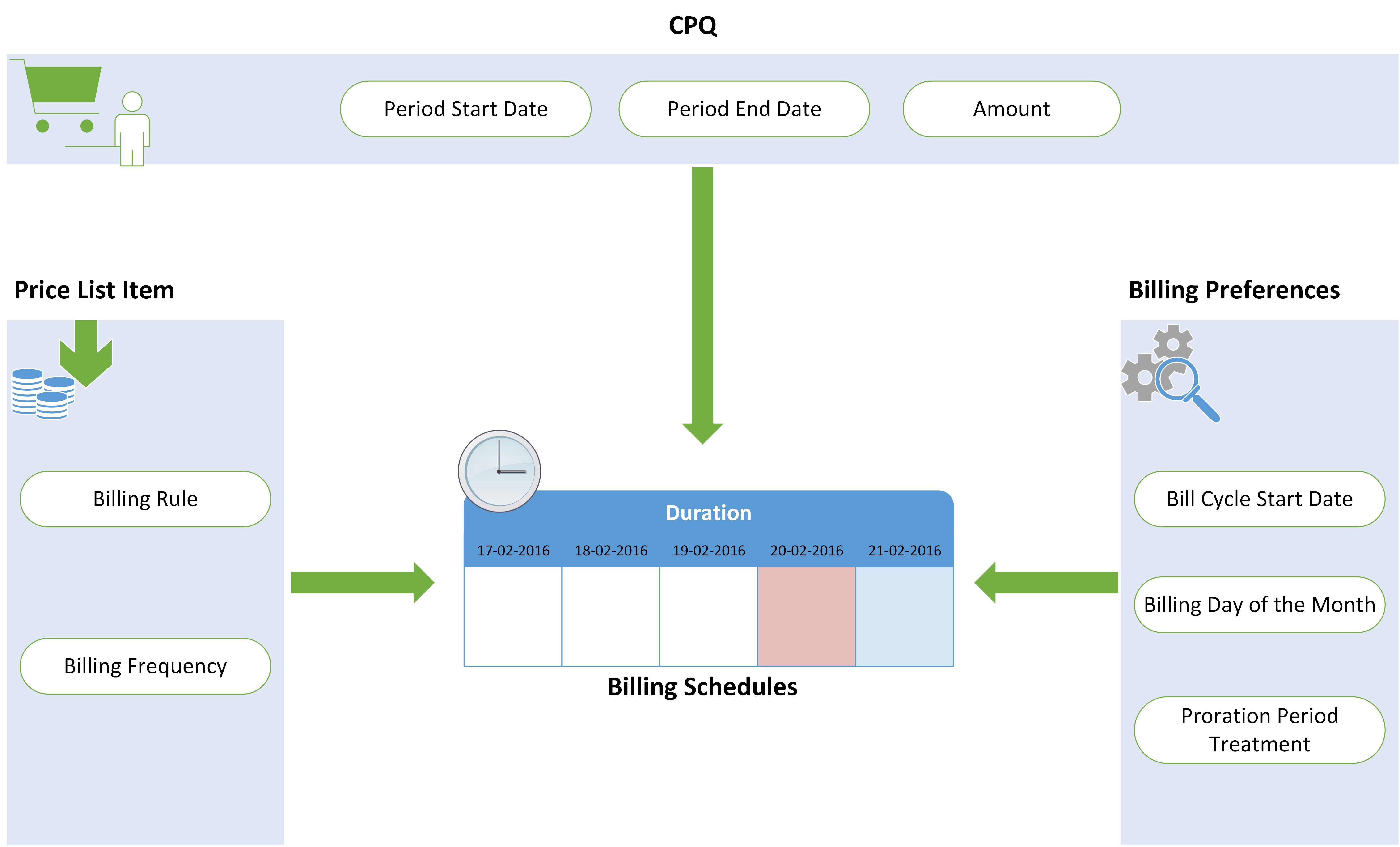Download PDF
Download page Understanding Billing Schedules.
Understanding Billing Schedules
Billing schedules for a product (whether one-time or recurring) are a distribution of the net amount of a contract, based on the chosen billing frequency. Billing schedules determine the amount that should be billed to the customer once or over a period of time.
With every order and subsequent asset that you activate, Conga Billing automatically creates a billing schedule for that asset. You can use the billing schedules function to track all billing information related to an asset and order. These billing schedules are adjusted for proration and asset-based orders.

Billing schedules take input from a variety of sources - CPQ, Price List Item, and Billing Preferences Setup, as shown in the above diagram.
For subscription-based recurring products, the net amount is distributed over a series of billing schedules. Each schedule displays the amount that may be invoiced for a specific duration based on billing frequency, along with the date when payments are due based on the payment term.
When you perform Invoice Runs to generate invoices, the appropriate billing schedules with Ready for Invoice Date less than or equal to the invoice Process Through Date are picked and mapped to the invoice line items.
A customer's billing schedule for each of the assets on their accounts page is shown:

The billing schedule displays these fields:
| Field | Description |
|---|---|
| Is Superseded | A system flag that denotes if a billing schedule has been superseded due to an amendment or cancellation. |
Ready for Invoice Date | The date on which this Billing Schedule is ready for invoicing. |
Period Start Date | The date when the customer starts getting billed for this purchase. |
Period End Date | The date until which the customer is billed for this purchase. |
| Status | The billing schedule's current stage in the process. |
| Type | There are two types of Billing Schedules:
|
Fee Amount | The bill amount corresponding to a Billing Schedule. |
Order Line Item | The line item created for the order for which the billing schedules are created. |
Payment Term | The payment term you will apply to the invoice. This is the number of days the invoice payment is due. The standard payment terms are:
|
Account Location | The location of the account to which the order is billed. |
Ship to Account | The account from which the purchase was made. |
Billing Rule | The billing rule you defined on the product PLI (Bill in Advance, Bill in Arrears, or Bill on Ready for Billing Date). |
Legacy record? | Select this checkbox to convey to Conga Billing that the billing schedule record is a legacy record and has been invoiced elsewhere. After the billing schedule is created, you cannot edit this checkbox or edit the billing schedule record itself. |
Superseded Billing Schedule | The billing schedule that is generated after the original one is superseded following an amendment or cancellation. |
Note
The period start date and period end date on a one-time product's billing schedule reflects the start and end dates you defined on the quote/proposal page. The same behavior applies to products with a recurring or usage frequency. This is beneficial in tracking mid-term product cancellations.
You can invoice these billing schedules through invoice runs. To update assets, see Managing Assets.
Billing Schedule Status
A regular billing cycle moves through each of the following statuses sequentially in a product's billing schedules:
- Pending Billing
Whenever a new billing schedule is created, its status is marked as "Pending Billing". Unless the schedule is not filtered for invoicing, this status will not change. - Pending Invoice
After an invoice run, if a billing schedule qualifies for invoicing, the status changes to "Pending Invoice". - Invoiced
If an invoice is approved, the status changes to "Invoiced".
For amendments and cancellations, the status changes to:
- Superseded
If a billing schedule is overwritten by new billing schedules. - Cancelled
If you terminate a product with the status "Pending Billing" or "Pending Invoice", the billing schedules after the termination date will be marked as "Cancelled". No further action will be taken for the billing schedules with cancelled status. - Invoice Cancelled
If you terminate a product with the status "Invoiced", the billing schedules after the termination date are marked as "Invoice Cancelled".
Billing Schedule Category
The billing schedule category is as follows:
- Fee: A billing schedule generated for a regular product is in the Fee category.
Cart Credit: A billing schedule generated for a negatively priced product is in the Cart Credit category.
Adding Fields to Legacy Asset Line Items for Billing Schedule
Adding any field to a legacy asset line item has a defined effect on the billing schedule. Consider the following definitions before changing a legacy asset line item.
| Field | Definition |
|---|---|
| Is Legacy For Billing | Indicates that an asset line is considered a legacy record for billing purposes. Conga Billing supports billing for legacy asset line items. Select this checkbox to identify a line item as a legacy asset. |
| Remaining Billable Amount | How much remains to be billed for the legacy asset line item after it is migrated to Conga? Whenever the status of a billing schedule changes from Pending Billing to Invoiced or from Invoiced to Pending Billing, Conga Billing updates this field. |
| First Billing Date | Determines the first day of billing an asset line item in Conga. This field is primarily used for legacy asset records. However, you can extend it to some regular asset line records. |